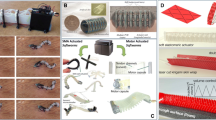Abstract
Many recent designs of soft robots and nano-robots feature locomotion mechanisms that cleverly exploit slipping and sticking phenomena. These mechanisms have many features in common with peristaltic locomotion found in the animal world. The purpose of the present paper is to examine the energy efficiency of a locomotion mechanism that exploits friction. With the help of a model that captures most of the salient features of locomotion, we show how locomotion featuring stick-slip friction is more efficient than a counterpart that only features slipping. Our analysis also provides a framework to establish how optimal locomotion mechanisms can be selected.












Similar content being viewed by others
Notes
While the energy \(e_5\) dissipated for \(\omega =0.95\omega _{n_1}\) does decrease after a certain amplitude \(a\) is reached, this region in parameter space is not feasible because when the two mass are too close to each other there is a possibility that the normal force on one of them will vanish and that mass would then loose contact with the ground.
References
Chernous’ko, F.L.: The optimum rectilinear motion of a two-mass system. J. Appl. Math. Mech. 66(1), 1–7 (2002). doi:10.1016/S0021-8928(02)00002-3
Denny, M.: The role of gastropod pedal mucus in locomotion. Nature 285(1), 160–161 (1980). doi:10.1038/285160a0
Donald, B., Levey, C., McGray, C., Rus, D., Sinclair, M.: Power delivery and locomotion of untethered microactuators. J. Microelectromech. Syst. 12(6), 947–959 (2003). doi:10.1109/JMEMS.2003.821468
Driesen, W.: Concept, modeling and experimental characterization of the modulated friction inertial drive (MFID) locomotion principle: Application to mobile microrobots. Ph.D. thesis, École Polytechnique Fédérale de Lausanne (2008). http://infoscience.epfl.ch/record/121454
Driesen, W., Rida, A., Breguet, J.M., Clavel, R.: Friction based locomotion module for mobile Mems robots. In: IEEE/RSJ International Conference on Intelligent Robots and Systems, 2007. IROS 2007, pp. 3815–3820 (2007). doi:10.1109/IROS.2007.4399321
Edeler, C., Meyer, I., Fatikow, S.: Modeling of stick-slip micro-drives. J. Micro-Nano Mechatron. 6(3–4), 65–87 (2011). doi:10.1007/s12213-011-0034-9
Elder, H.Y.: Peristaltic mechanisms. In: Elder, H.Y., Trueman, E.R. (eds.) Aspects of Animal Movement, vol. 5, pp. 71–92. Society for Experimental Biology, Seminar Series, Cambridge University Press, Cambridge, UK (1985)
Frutiger, D., Kratochvil, B., Nelson, B.: MagMites—Microrobots for wireless microhandling in dry and wet environments. In: 2010 IEEE International Conference on Robotics and Automation (ICRA), pp. 1112–1113 (2010). doi:10.1109/ROBOT.2010.5509678
Li, H., Furuta, K., Chernousko, F.: Motion generation of the Capsubot using internal force and static friction. In: 45th IEEE Conference on Decision and Control, pp. 6575–6580 (2006). doi:10.1109/CDC.2006.377472
Majidi, C.: Soft robotics: a perspective—current trends and prospects for the future. Soft Robot. 1(P), 5–11 (2013). doi:10.1089/soro.2013.000
McNeil Alexander, R.: Principles of Animal Locomotion. Princeton University Press, Princeton (2003)
Murthy, R., Das, A., Popa, D.O.: ARRIpede: a stick-slip micro crawler/conveyor robot constructed via 2.5D MEMS assembly. In: IEEE/RSJ International Conference on Intelligent Robots and Systems, 2008. IROS 2008, pp. 34–40 (2008). doi:10.1109/IROS.2008.4651181
Murthy, R., Das, A., Popa, D.O., Stephanou, H.E.: ARRIpede: An assembled die-scale microcrawler. Adv. Robot. 25(8), 965–990 (2011). doi:10.1163/016918611X568602
Nagy, Z., Frutiger, D., Leine, R., Glocker, C., Nelson, B.: Modeling and analysis of wireless resonant magnetic microactuators. In: 2010 IEEE International Conference on Robotics and Automation (ICRA), pp. 1598–1603 (2010). doi:10.1109/ROBOT.2010.5509260
Nagy, Z., Leine, R., Frutiger, D., Glocker, C., Nelson, B.: Modeling the motion of microrobots on surfaces using nonsmooth multibody dynamics. IEEE Trans. Robot. 28(5), 1058–1068 (2012). doi:10.1109/TRO.2012.2199010
Nakazato, Y., Sonobe, Y., Toyama, S.: Development of an in-pipe micro mobile robot using peristalsis motion. J. Mech. Sci. Technol. 24(1), 51–54 (2010). doi:10.1007/s12206-009-1174-x
Pawashe, C., Floyd, S., Sitti, M.: Modeling and experimental characterization of an untethered magnetic micro-robot. Int. J. Robot. Res. 28(8), 1077–1094 (2009). doi:10.1177/0278364909341413
Seok, S., Onal, C.D., Cho, K.J., Wood, R.J., Rus, D., Kim, S.: Meshworm: A peristaltic soft robot with antagonistic nickel titanium coil actuators. IEEE/ASME Trans. Mechatron. 18(5), 1485–1497 (2013). doi:10.1109/TMECH.2012.2204070
Shepherd, R.F., Ilievski, F., Choi, W., Morin, S.A., Stokes, A.A., Mazzeo, A.D., Chen, X., Wang, M., Whitesides, G.M.: Multigait soft robots. In: Proceedings of the National Academy of Sciences, USA, vol. 108, no. 51, pp. 20400–20403 (2011). doi:10.1073/pnas.1116564108
Sitti, M.: Miniature devices: voyage of the microrobots. Nature 458(7242), 1121–1122 (2008). doi:10.1038/4581121a
Suzuki, Y., Li, H., Furuta, K.: Locomotion generation of friction board with an inclined slider. In: 46th IEEE Conference on Decision and Control, 2007, pp. 1937–1943 (2007). doi:10.1109/CDC.2007.4434269
Tanaka, Y., Ito, K., Nakagaki, T., Kobayashi, R.: Mechanics of peristaltic locomotion and role of anchoring. J. R. Soc. Interface 9(67), 222–233 (2012). doi:10.1098/rsif.2011.0339
Wood, R.: The first takeoff of a biologically inspired at-scale robotic insect. IEEE Trans. Robot. 24(2), 341–347 (2008). doi:10.1109/TRO.2008.916997
Zimmermann, K., Zeidis, I.: Worm-like locomotion as a problem of nonlinear dynamics. J. Theor. Appl. Mech. 45(1), 179–187 (2007)
Acknowledgments
Support from a Defense Advanced Research Projects (DARPA) 2012 Young Faculty Award to Carmel Majidi is gratefully acknowledged. Xuance Zhou is grateful for the support of a Anselmo Macchi Fellowship for Engineering Graduate Students and a J. K. Zee Fellowship. The authors also take this opportunity to thank an anonymous reviewer for their constructive criticisms.
Author information
Authors and Affiliations
Corresponding author
Rights and permissions
About this article
Cite this article
Zhou, X., Majidi, C. & O’Reilly, O.M. Energy efficiency in friction-based locomotion mechanisms for soft and hard robots: slower can be faster. Nonlinear Dyn 78, 2811–2821 (2014). https://doi.org/10.1007/s11071-014-1627-3
Received:
Accepted:
Published:
Issue Date:
DOI: https://doi.org/10.1007/s11071-014-1627-3




